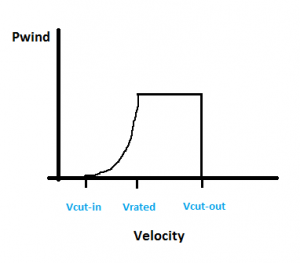
The wind turbine uses the power from the wind to power an electric generator to create an electric current. The most common wind turbine is the horizontal axis wind turbine or the HAWT, which is shown above. This turbine has three blades and is designed to operate upwind, which means is placed into the wind. If the wind direction changes the computer controlled turbine changes directions accordingly. The power produced from these turbines is equal to (1/2)*atmospheric pressure*surface area of the rotor*velocity of the wind cubed (P = (1/2)pA(v^3)). So a slight increase in the wind is a cubic increase of the power.
The Power Curve
The HAWT has a rated speed at which it outputs maximum power. Most turbines have a “cut in speed” or the speed that the turbine needs the start rotating. To prevent damage from the turbine from strong winds, the turbine also a maximum speed at which it stops generating power. The power curve for the wind turbine is shown below.

Efficiency and Betz Law
The amount of power in wind is not the amount power that the wind turbine can generate. Betz Law states that maximum efficiency for a given wind turbine is approximately .593. This means that at the most wind turbines can only extract 59.3% of the power in the wind. The average American turbine has efficiency of approximately 30%. High speed turbines placed at heights of above 50 m have about 50% efficiency. Acceptable efficiency for a wind turbine is 35%.
Sources
http://en.wikipedia.org/wiki/Wind_generation_potential_in_the_United_States
Edited: 11/27/12 by Andria Young, young10@illinois.edu
Note: This email will not be checked regularly after 12/22/12

